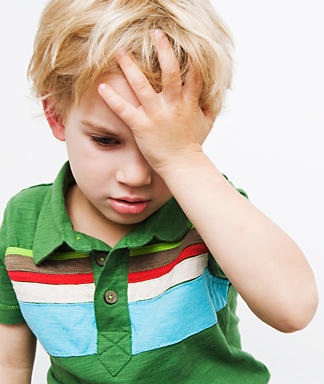Headaches are a common complaint throughout childhood, but pediatricians have recognized that children have many different types of headaches, including migraines. Migraine headaches are best diagnosed by obtaining a detailed medical history and then conducting a thorough neurological exam.
Several characteristics of childhood migraines are quite different from those associated with adult migraines. While adult females have a higher incidence of migraine headaches, males predominate in the childhood population.
Childhood migraines often are shorter in duration than adult migraines and are less often unilateral (one-sided) than in adults. Only 25 percent to 60 percent of children will describe a unilateral headache, while 75 percent to 90 percent of adults have unilateral pain.
Children suffered from migraines don't typically have visual auras like adults, but may have a behavioral change with irritability, pallor, malaise, or loss of appetite proceeding the headache. Only about 18 percent of children describe migraine with an aura and another 13 percent may have migraines with and without auras at different times.
When taking a history, it's also important to ask about any family history of migraines, as these headaches seem to run in families. Children who develop migraines were often "fussy" infants, and they also have an increased incidence of sleep disorders, including night terrors and nightmares. Many parents and children who get migraines also report a history of motion sickness.
When children discuss their headaches, they often complain of feeling dizzy (although, after further questioning, this actually sounds more like being lightheaded than suffering from vertigo). They may also complain of blurred vision, abdominal pain, nausea and vomiting, chills, sweating, or even feeling feverish. Children with migraines appear ill, uncomfortable and pale, and will often have dark circles around their eyes.
It seems that migraine headaches in childhood may be precipitated by hunger, lack of sleep, and stress. Keep in mind that "stress" for a child may be positive, such as being excited, as well as negative.
Children with migraines will also tell you their headaches are aggravated by physical activity (including going up and down stairs, carrying a backpack, or even just bending over). Many complain of photophobia (light sensitivity) and phonophobia (sensitive to noises) and typically a parent will report that their child goes to bed in a dark room or goes to sleep when experiencing these symptoms.
Children with migraines don't watch TV or play video games during their headaches. They are quiet, may not want to eat, and may just want to rest. Nothing active typically "sounds" like fun to them.
To meet the diagnostic criteria for childhood migraine, a child needs to have at least five such "attacks." A headache log is useful, as these headaches may occur randomly and it's difficult to remember what each headache was like, or how long it lasted, without keeping a log.
Read more here

No comments:
Post a Comment